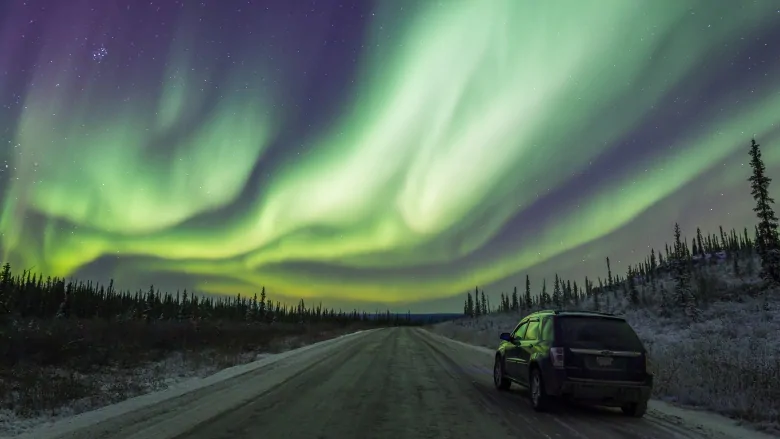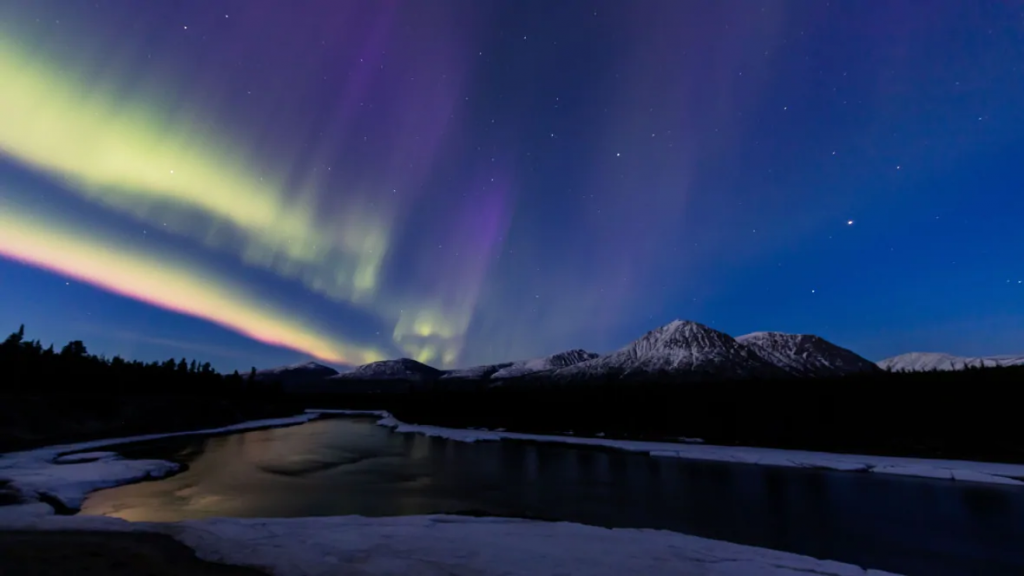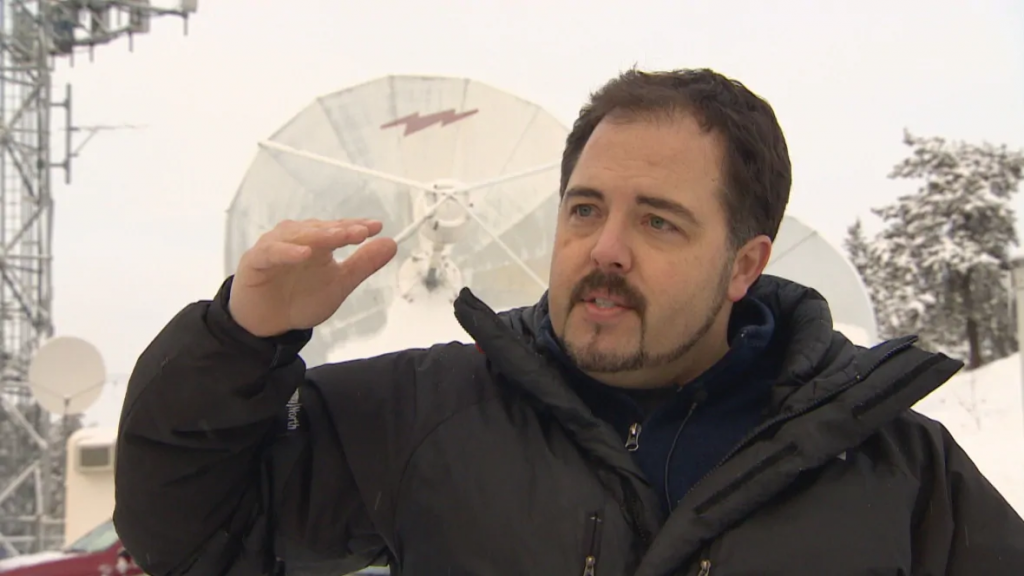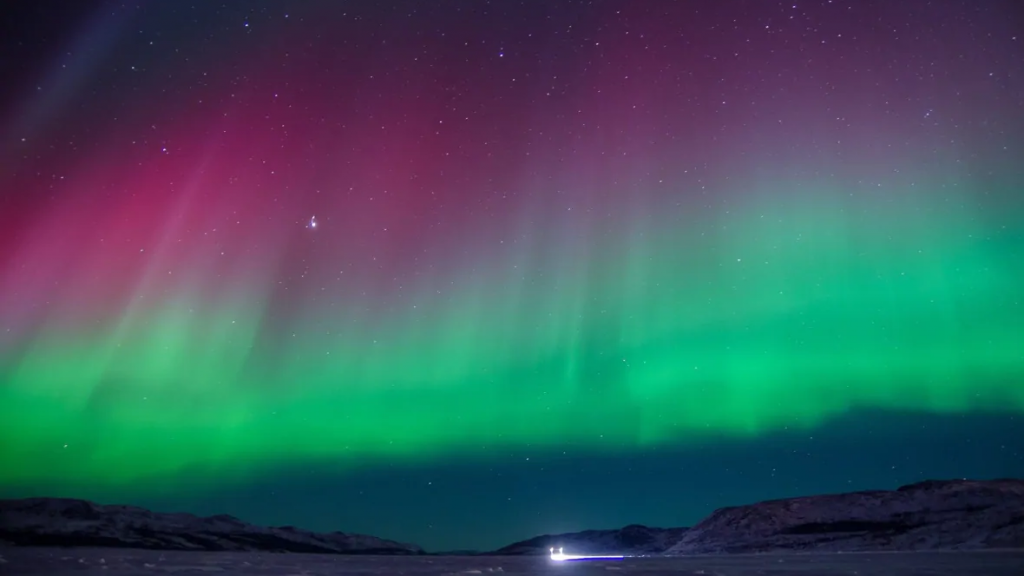What are the northern lights?

Across the North, vibrant aurora borealis dance and ripple across the sky practically every night in the winter.
Most people know that the northern lights are a scientific phenomenon happening up above, but do you really know what causes them?
CBC explains.
What is the aurora borealis?
The northern lights are caused by particles — electrons and protons — blasted out from the sun in all directions and colliding with gases in the Earth’s atmosphere.
Those particles travel 150 million kilometres from the sun to reach Earth, which takes about two to four days, according to James Pugsley, an aurora forecaster with Astronomy North. They are part of a stream of energy called the solar wind. As the Earth orbits the sun, a portion of those particles collide with the Earth’s magnetic field.

“A lot of particles, when they reach the magnetic field are deflected away into space, but some become trapped in the magnetic field,” Pugsley said.
The trapped ones are directed toward the north and south magnetic poles — wandering points on Earth’s surface that move due to changes in its magnetic field. They follow magnetic field lines and pour into the atmosphere.
“There’s this little spark that occurs, this release of energy that we see in the form of light. And so now imagine that overhead there are billions of these tiny little sparks going on in the sequence of light, these little flashes of light are what we see and call aurora,” he said.
“So if you’re living in northern Canada, or northern Scandinavia, northern Russia, around the north magnetic pole, and you look up, what you’re seeing is this waterfall of particles … pouring into the atmosphere.”

Why are they different colours?
The Earth’s atmosphere is made up of nitrogen, oxygen and other gases, commonly known as air. The colours of the aurora depends on the gas molecules the particles are interacting with.
Pugsley says that as the particles get closer to Earth, the oxygen and nitrogen content is so thick the particles can’t go much further.
Watch us break down the northern lights:
“When we see green in the sky, which is the most common of the colours, green is an indication that a charged particle from the sun is interacting with oxygen,” Pugsley said.
Green is the most common colour because it takes more energy, or a pretty intense event, to spark nitrogen.
“When we see blues and purples, generally along the lower edge, we see a really intense, very vibrant purple colour, that’s an indication of that particles interacting with nitrogen.”
How high up are the northern lights?
Aurora are between 100 and 500 kilometres above the surface of the planet. To give you an idea of how high up that is, the International Space Station orbits the Earth at about 400 kilometres above the surface.
“We have low-Earth-orbit satellites, and the International Space Station, actually cruising across the top of the tallest auroras,” Pugsley said.

Why do they dance?
Pugsley says the northern lights are not easily explained or fully understood.
He said one possible explanation is that as the activity increases, the magnetic line starts to move, with an influx of particles breaking up, “turning on the taps,” or dancing.
The solar wind generally blows around 400 kilometres per second. But a really intense event on the sun can lead to gusts of up to 800 kilometres per second.
James Pugsley, Astronomy North
“That kind of event, along with a lot of other dynamics that go on in the magnetic field, can cause those particles to really pour into the atmosphere,” he said.
“When we watch that dazzling display of light, it’s actually telling us a story. It’s a story that began on the sun, travelled all the way to Earth, had a series of interactions in the magnetic field and led to this beautiful display overhead.”
Why are they more visible in the North?
If you’re at high latitudes anywhere on the planet — with access to clear, dark skies in the spring, winter and fall, of course — chances are every single night there is auroral activity overhead.
The northern lights we see are a small section of the “auroral oval” — a huge ring or crown of aurora above the Earth’s geomagnetic north pole.
Pugsley says northern locations are the “perfect zone” because they’re close to the auroral oval. When there is active space weather, like a geomagnetic storm (a disturbance of the magnetic field surrounding Earth), it can push the auroral oval like an elastic band further south. That can result in northern lights being visible right across the country and even as far south as the United States.
“It’s a very dynamic structure. You know when we’re talking about magnetic field lines, we’re not talking about something that’s rigid and stuck in one spot,” Pugsley said.

When southerners can see the aurora though, Pugsley said there can be an important distinction: is it directly above them, or is it actually above northern Canada but you can see it from the south?
“And that’s still cool too because the side view of an aurora can give you an unbelievable show. It shows you how tall an aurora can be,” he said.
Why is there so much mystery?
“The most experienced scientists say that for every question that’s answered, there are 10 more that need to be answered,” Pugsley said.
He said scientists are always looking at new missions to better understand the relationship between the sun and the Earth, forecasting auroras and space weather, such as the Solar Orbiter mission that’s launching in February 2020.
James Pugsley, Astronomy North

He notes that modern day technology, like cellphones, also depend on that research since satellites can be affected by the solar wind.
“The more that we study the conditions, the more that we study the sun, the better our chances are predicting or forecasting these events,” he said.
“It’s really, truly a scientific wonder, and there’s a lot that we still don’t know about when it comes to the aurora.
“It’s a beautiful way to watch the sun and the Earth and their magnetic connection. And it tells a beautiful scientific story.”
Related stories from around the North:
Canada: What ‘young’ Arctic rocks tell us about origins of the Earth and Moon, Radio Canada International
Finland: Finland to headquarter Europe’s new atmospheric research center, Yle News
Greenland: Evidence of powerful solar storm which occurred 2,600 years ago found in Greenland ice, CBC News
Norway: NASA and Norway to develop observation station in Arctic, The Independent Barents Obsever
Russia: Scientists surprised to discover meteor exploded over Bering Sea in December, CBC News
Sweden: Meteorite from Arctic Sweden fetches thousands at auction, Radio Sweden
United States: New map shows what Bering land bridge looked like 18,000 years ago, CBC News




Is there ever a time when the ISS cannot see the aurora? And is the aurora always active?